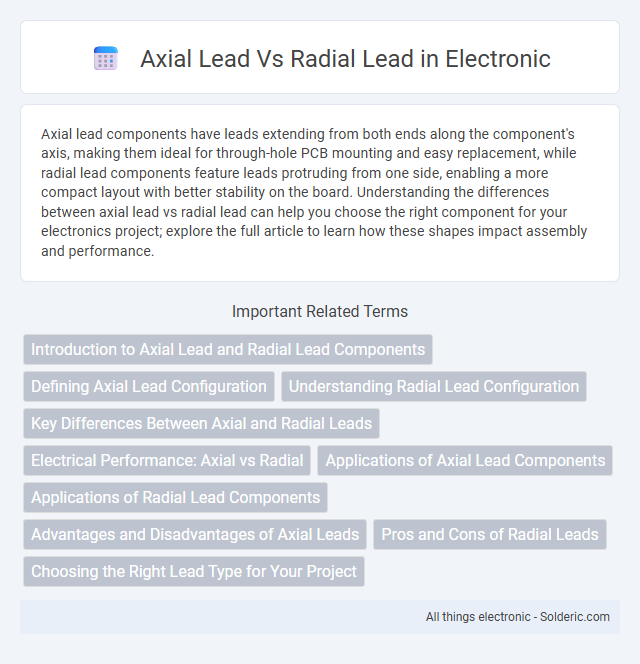Axial lead components have leads extending from both ends along the component's axis, making them ideal for through-hole PCB mounting and easy replacement, while radial lead components feature leads protruding from one side, enabling a more compact layout with better stability on the board. Understanding the differences between axial lead vs radial lead can help you choose the right component for your electronics project; explore the full article to learn how these shapes impact assembly and performance.
Comparison Table
| Feature | Axial Lead | Radial Lead |
|---|---|---|
| Lead Orientation | Leads extend from both ends along the axis | Leads extend from the same side |
| PCB Mounting | Horizontal mounting on PCB | Vertical mounting on PCB |
| Size | Longer length, narrow profile | Shorter length, wider footprint |
| Applications | Through-hole technology, space-constrained linear layouts | Through-hole technology, compact PCB areas |
| Manufacturing Cost | Generally lower cost | Generally higher cost due to complexity |
| Mechanical Strength | Moderate mechanical stability | Higher mechanical stability due to compact design |
Introduction to Axial Lead and Radial Lead Components
Axial lead components feature wire leads extending from both ends along the component's axis, making them suitable for through-hole PCB mounting and allowing easy insertion in narrow spaces. Radial lead components have both leads emerging from the same side of the component body, enabling more compact vertical mounting and higher component density on circuit boards. Selection between axial and radial leads depends on design requirements, including board layout, space constraints, and manufacturing processes.
Defining Axial Lead Configuration
Axial lead components feature leads extending from both ends of a cylindrical or tubular body, allowing them to lie flat against circuit boards for streamlined assembly. This configuration enhances mechanical stability and is ideal for through-hole mounting in tightly spaced circuit layouts. Capacitance, resistance, and inductance values are commonly standardized within axial lead designs for consistency across electronic applications.
Understanding Radial Lead Configuration
Radial lead components feature two leads extending from the same side of the device, making them ideal for space-saving designs on printed circuit boards (PCBs). This configuration enhances mechanical stability and simplifies automated assembly processes, which is beneficial for mass production. Your choice of radial lead components can improve circuit reliability and optimize layout efficiency, especially in compact electronic devices.
Key Differences Between Axial and Radial Leads
Axial leads extend from both ends of a component, allowing it to be mounted parallel to the circuit board, while radial leads protrude from one side, enabling vertical mounting. Axial lead components typically fit better in narrow spaces and provide easier visual inspection, whereas radial leads save board space and offer improved mechanical stability. Your choice between axial and radial leads depends on the specific layout, space constraints, and assembly requirements of your electronic design.
Electrical Performance: Axial vs Radial
Axial lead components typically offer better electrical performance in high-frequency applications due to their lower inductance and improved signal integrity compared to radial leads. Radial lead components are often favored for compact PCB layouts but may introduce higher parasitic inductance, affecting your circuit's efficiency in sensitive designs. Selecting between axial and radial leads depends on the required electrical characteristics and space constraints in your project.
Applications of Axial Lead Components
Axial lead components are widely used in applications requiring through-hole mounting and ease of manual assembly, such as in vintage audio equipment, power supplies, and automotive circuits. Their elongated shape allows for tighter spacing on printed circuit boards while maintaining strong mechanical stability under stress and vibration. Your projects benefit from enhanced durability and reliable electrical connections when using axial lead components in these demanding environments.
Applications of Radial Lead Components
Radial lead components are widely used in applications requiring compact circuit design due to their small footprint and ease of automated insertion on printed circuit boards (PCBs). These components are ideal for consumer electronics, power supplies, and LED lighting, where space efficiency and reliable mechanical stability are critical. You can optimize your device assembly by choosing radial lead components for dense multi-layer PCB configurations.
Advantages and Disadvantages of Axial Leads
Axial lead components offer advantages such as easy insertion into through-hole PCBs and better alignment for automated assembly processes, making them ideal for compact circuit layouts. Their symmetrical shape allows for uniform stress distribution along the lead axis, reducing the risk of damage during handling or soldering. However, axial leads can be less space-efficient than radial leads, often requiring more board area and limiting their use in densely packed electronic designs.
Pros and Cons of Radial Leads
Radial leads offer compact and space-efficient mounting, making them ideal for high-density circuit boards and automated assembly processes due to their bottom-exiting leads. Their design provides better mechanical stability and lower profile compared to axial leads, which helps reduce the overall height of electronic components. However, radial leads can be challenging to replace or repair since both leads emerge from the same side, limiting flexibility in circuit design and maintenance compared to axial components.
Choosing the Right Lead Type for Your Project
Selecting between axial lead and radial lead components depends on your project's space constraints and mounting preferences. Axial leads extend from both ends of the component, making them ideal for through-hole mounting on narrow boards and ensuring stability in high-vibration environments. Radial leads emerge from the same side, saving vertical space and allowing for compact circuit designs; understanding these differences helps you optimize component placement and overall device performance.
axial lead vs radial lead Infographic

 solderic.com
solderic.com